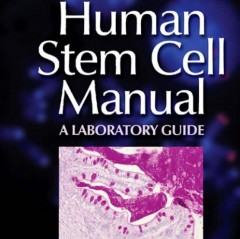
Human Stem Cell Manual: A Laboratory Guide
Edited by: Jeanne F. Loring, Robin L. Wesselschmidt and Philip H. Schwartz
Elsevier: 2007, ISBN: 978-0-12-370465-8
Foreword by James Battey Foreword by Jeannie Fontana Preface Part I: Basic methods: Maintenance of stem cell cultures 1.Human Embryonic Stem Cell Culture 2.Feeder layers and feeder-free culture 3.Mouse Embryonic Fibroblast Feeder Cells 4.Cryopreservation of hESC Part II: Basic methods: Characterization of stem cells 5.Classical Cytogenetics: Karyotyping 6.Spectral Karyotyping and Fluorescent in situ Hybridization 7.Using SNP Genotyping to Identify Cell Lines, Determine Genomic Abnormalities and Monitor DNA Methylation Patterns 8.FACS/Cell sorting 9.Fluorescence Immunocytochemical Analysis of Stem Cells 10.Characterization of Stem Cells Using RT-PCR 11.Gene Expression Profiling of Stem Cells by Microarray 12.Teratomas produced from Human Embryonic Stem Cells Xenografted into Immunodeficient Mice 13.Generation of HESC-Derived Teratomas Part III: Differentiation of stem cells 14.?Embryoid Body? Formation and Neuroepithelia Differentiation 15.Motor Neuron and Dopamine Neuron Differentiation 16.Oligodendrocyte Differentiation from hESC 17.Cardiac 18.Hematopoietic Part IV: Genetic manipulation of stem cells 19.Genetic Manipulation of hESC: Lentivirus Vectors 20.Methods developed for mouse ES cells Part V: Advanced methods 21.Derivation of human ES cells 22.Neural Stem Cell Culture 23.Transplantation of stem cells 24.In vitro fertilization 25.Functional characterization-neural cells Part VI: Practical issues in establishing a human ES cell laboratory 26.Setting Up a Facility for hESC Research Part VII: Essays on stem cell biology 27.Intellectual Property: Owning the Stem Cell 28.Ethical Concerns for Stem Cell Research 29.Guidelines for hESC Research Oversight (ESCRO) Committees